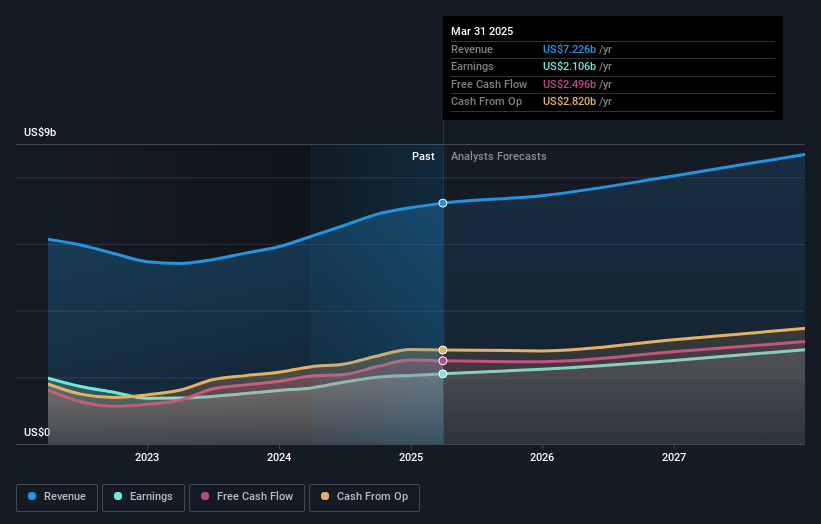
A week ago, Moody's Corporation (NYSE:MCO) came out with a strong set of first-quarter numbers that could potentially lead to a re-rate of the stock. The company beat expectations with revenues of US$1.9b arriving 2.5% ahead of forecasts. Statutory earnings per share (EPS) were US$3.46, 6.0% ahead of estimates. Earnings are an important time for investors, as they can track a company's performance, look at what the analysts are forecasting for next year, and see if there's been a change in sentiment towards the company. We thought readers would find it interesting to see the analysts latest (statutory) post-earnings forecasts for next year.
Our free stock report includes 2 warning signs investors should be aware of before investing in Moody's. Read for free now.
Taking into account the latest results, the current consensus from Moody's' 22 analysts is for revenues of US$7.45b in 2025. This would reflect an okay 3.1% increase on its revenue over the past 12 months. Statutory earnings per share are predicted to rise 5.9% to US$12.40. Yet prior to the latest earnings, the analysts had been anticipated revenues of US$7.54b and earnings per share (EPS) of US$12.72 in 2025. The analysts seem to have become a little more negative on the business after the latest results, given the small dip in their earnings per share numbers for next year.
Check out our latest analysis for Moody's
The consensus price target held steady at US$502, with the analysts seemingly voting that their lower forecast earnings are not expected to lead to a lower stock price in the foreseeable future. Fixating on a single price target can be unwise though, since the consensus target is effectively the average of analyst price targets. As a result, some investors like to look at the range of estimates to see if there are any diverging opinions on the company's valuation. The most optimistic Moody's analyst has a price target of US$572 per share, while the most pessimistic values it at US$445. The narrow spread of estimates could suggest that the business' future is relatively easy to value, or thatthe analysts have a strong view on its prospects.
Looking at the bigger picture now, one of the ways we can make sense of these forecasts is to see how they measure up against both past performance and industry growth estimates. We would highlight that Moody's' revenue growth is expected to slow, with the forecast 4.1% annualised growth rate until the end of 2025 being well below the historical 5.2% p.a. growth over the last five years. Compare this against other companies (with analyst forecasts) in the industry, which are in aggregate expected to see revenue growth of 5.2% annually. So it's pretty clear that, while revenue growth is expected to slow down, the wider industry is also expected to grow faster than Moody's.
The Bottom Line
The biggest concern is that the analysts reduced their earnings per share estimates, suggesting business headwinds could lay ahead for Moody's. On the plus side, there were no major changes to revenue estimates; although forecasts imply they will perform worse than the wider industry. The consensus price target held steady at US$502, with the latest estimates not enough to have an impact on their price targets.
With that said, the long-term trajectory of the company's earnings is a lot more important than next year. We have estimates - from multiple Moody's analysts - going out to 2027, and you can see them free on our platform here.
And what about risks? Every company has them, and we've spotted 2 warning signs for Moody's you should know about.
Have feedback on this article? Concerned about the content? Get in touch with us directly. Alternatively, email editorial-team (at) simplywallst.com.
This article by Simply Wall St is general in nature. We provide commentary based on historical data and analyst forecasts only using an unbiased methodology and our articles are not intended to be financial advice. It does not constitute a recommendation to buy or sell any stock, and does not take account of your objectives, or your financial situation. We aim to bring you long-term focused analysis driven by fundamental data. Note that our analysis may not factor in the latest price-sensitive company announcements or qualitative material. Simply Wall St has no position in any stocks mentioned.